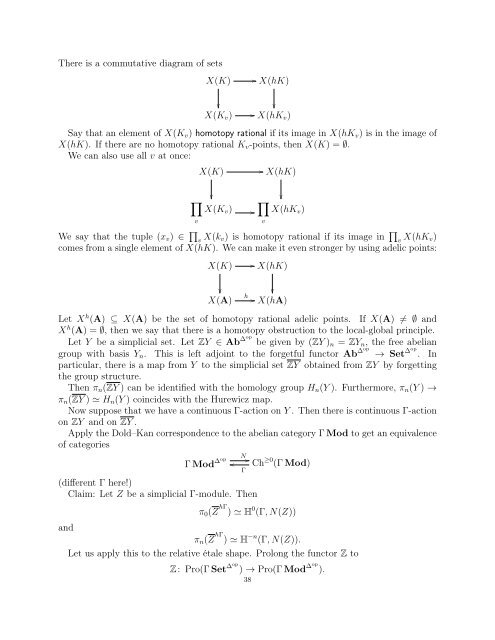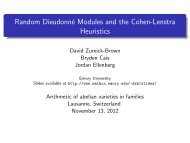alternative lecture notes - Rational points and algebraic cycles
alternative lecture notes - Rational points and algebraic cycles
alternative lecture notes - Rational points and algebraic cycles
Create successful ePaper yourself
Turn your PDF publications into a flip-book with our unique Google optimized e-Paper software.
There is a commutative diagram of sets<br />
X(K)<br />
X(hK)<br />
X(K v ) X(hK v )<br />
Say that an element of X(K v ) homotopy rational if its image in X(hK v ) is in the image of<br />
X(hK). If there are no homotopy rational K v -<strong>points</strong>, then X(K) = ∅.<br />
We can also use all v at once:<br />
X(K)<br />
∏<br />
X(K v )<br />
v<br />
X(hK)<br />
∏<br />
X(hK v )<br />
We say that the tuple (x v ) ∈ ∏ v X(k v) is homotopy rational if its image in ∏ v X(hK v)<br />
comes from a single element of X(hK). We can make it even stronger by using adelic <strong>points</strong>:<br />
X(K)<br />
v<br />
X(hK)<br />
X(A)<br />
h<br />
X(hA)<br />
Let X h (A) ⊆ X(A) be the set of homotopy rational adelic <strong>points</strong>. If X(A) ≠ ∅ <strong>and</strong><br />
X h (A) = ∅, then we say that there is a homotopy obstruction to the local-global principle.<br />
Let Y be a simplicial set. Let ZY ∈ Ab ∆op<br />
be given by (ZY ) n = ZY n , the free abelian<br />
group with basis Y n . This is left adjoint to the forgetful functor Ab ∆op → Set ∆op . In<br />
particular, there is a map from Y to the simplicial set ZY obtained from ZY by forgetting<br />
the group structure.<br />
Then π n (ZY ) can be identified with the homology group H n (Y ). Furthermore, π n (Y ) →<br />
π n (ZY ) ≃ H n (Y ) coincides with the Hurewicz map.<br />
Now suppose that we have a continuous Γ-action on Y . Then there is continuous Γ-action<br />
on ZY <strong>and</strong> on ZY .<br />
Apply the Dold–Kan correspondence to the abelian category Γ Mod to get an equivalence<br />
of categories<br />
Γ Mod N ∆op Ch ≥0 (Γ Mod)<br />
Γ<br />
(different Γ here!)<br />
Claim: Let Z be a simplicial Γ-module. Then<br />
π 0 (Z hΓ ) ≃ H 0 (Γ, N(Z))<br />
<strong>and</strong><br />
π n (Z hΓ ) ≃ H −n (Γ, N(Z)).<br />
Let us apply this to the relative étale shape. Prolong the functor Z to<br />
Z: Pro(Γ Set ∆op ) → Pro(Γ Mod ∆op ).<br />
38



